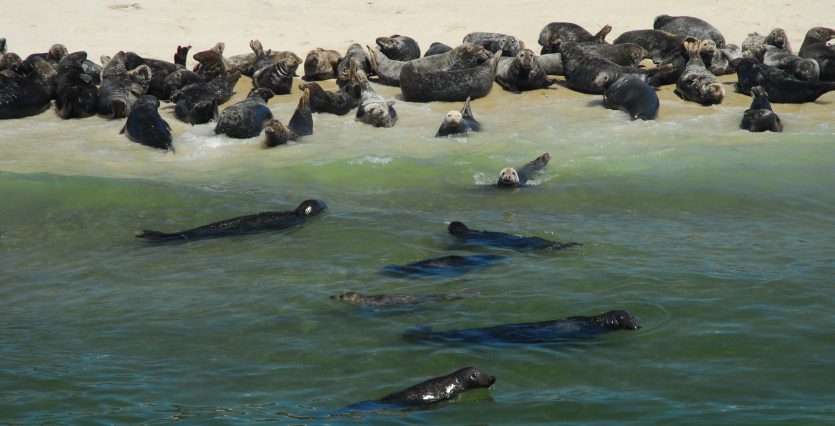While moviegoing audiences in 1975 flocked to the theaters to see Jaws, the movie itself seemed to have an opposite effect on the ocean-going public. The horror flick touched a primal nerve in many people. Traumatized by scenes of a mindless, toothy beast attacking helpless humans in the water, a large swath of the population developed a fear of the ocean. But for one 14-year-old boy, it had the exact opposite effect.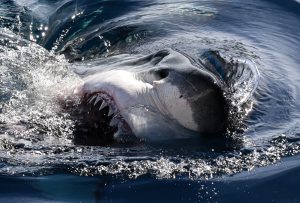
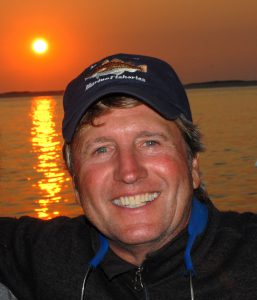
Dr. Greg Skomal grew up a stone’s throw from the ocean in Fairfield, Connecticut, but his love for the ocean and its creatures developed in a nontraditional way for someone who lived so close to the water. “Long Island Sound was not exactly a diving mecca back then,” Skomal says. “What had actually fueled my love for the ocean was TV … I’m not sure many parents would like to hear their kid say that. I used to love watching Jacques Cousteau, Sea Hunt, and even Flipper. What really made me want to become a shark biologist, though, was Matt Hooper.” Hooper, played by Richard Dreyfuss, was one of the heroes from Jaws. He was the scientist who came to help Chief Brody find out what was going on in the ocean off the sandy, white beaches of the fictional Amity Island. “The scene where they’re searching for the missing boat at night and Hooper goes for a dive where he discovers the shark’s tooth lodged in the hull … I wanted to do that!”
Undeterred by that horror film, a few years after he saw Jaws, he became certified as a diver. He then attended college at the University of Rhode Island where he studied zoology — there were very few marine biology majors offered at that time. After college, Skomal worked for the NMFS Cooperative Shark Tagging Program (a federal program), but as that job started winding up, he got word from a friend that the state of Massachusetts was hiring young scientists to work for its Division of Marine Fisheries. He applied for the job, got it and was stationed at the real-life version of Amity Island, Martha’s Vineyard, where he began his very own shark research program. “For years, I studied a variety of shark species and worked on collaborative projects all over the world, but in the 2000s, things started to change.” Skomal and his team began to receive more and more reports of something washing up on Massachusetts shores that would serve as a harbinger of what was to come.
The Gray Seals of the Northeast
Before humans dominated the Northeastern Seaboard of North America, gray seals lived in massive colonies all up and down the coast. Then humans began hunting them to use as food and for their fur, and in the 19th and 20th centuries, the population was hit hard when local governments put a bounty on them because these marine mammals competed for valuable fishing stocks. The bounty program that was put in place in both the U.S. and Canada nearly wiped them off the planet for good. In the 20th century, there was no viable breeding stock left in the U.S.
In 1965, the state of Massachusetts enacted legislation to protect gray seals, and in 1972, the U.S. federal government followed suit with the Marine Mammals Protection Act, which afforded the gray seals complete protection in the U.S. In the 46 years since then, the only remaining viable breeding colony, located on Sable Island, a Canadian island 175 kilometers (109 miles) southeast of Nova Scotia, spread to the U.S. mainland, and the seal populations have been growing and spreading ever since.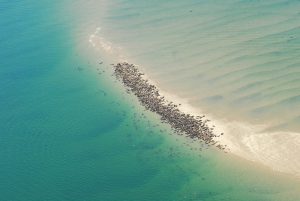
“It takes a while for mammal populations to rebound as a result of conservation efforts,” says Skomal. “They’re just now repopulating areas where they historically existed in large numbers. Where there were once less than 10,000 animals in the wild, estimates now put their population at around a half-million. The problem is that there really aren’t any models predicting how big that population will get. Is this an overpopulation? Is it a natural restoration? We’re not sure since there is no accurate historical data as to the size of the wild populations when man first arrived here. Most scientists assume the population of seals will reach a natural balance and plateau. In the meantime, some fishermen are screaming, ‘Who’s counting the seals and what they’re eating?’ There are a lot of unanswered questions. What will the impact of a growing seal population have on local fisheries? Back in the 1700s, commercial and recreational fisheries didn’t exist at the scale they do today. All of a sudden, there’s an abundance of this ‘new’ predator in the equation, and we’re trying to balance everyone’s interest.” It’s an unenviable job that fisheries managers around the world have — to balance the needs of commercial fishermen with the needs of a species to keep it from sliding into near extinction as the gray seals had. In recent times, however, nature seems to be presenting its own answer, but there are many people who aren’t thrilled with mother nature’s solution either.
“In the early 2000s, we began to receive reports of seal carcasses with what appeared to be large bites taken out of them washing up on Cape Cod beaches near Chatham (the bottom of the ‘elbow’ if Cape Cod were a flexed arm). It was subtle at first, but over that decade, the reports of mauled seal carcasses increased slowly but surely.” Something was starting to hunt the seals and in growing numbers and frequency.
The Recovery of White Shark Populations
It wasn’t until 2004 when Skomal was relaxing at home one summer evening when he received a call saying there was a possible great white shark in a small salt pond not far from Woods Hole. He didn’t believe it at first, but less than 24 hours later, he was staring at a live 13-foot great white that was trapped in this small pond. As a result, Skomal became the first person to tag a great white in the northern Atlantic with a high-tech satellite tracking tag. He and his team were successfully able to guide the leviathan back to its rightful home in the open ocean, but unfortunately for him, that tag was a dud, and they never received the data from that particular shark. Skomal was devastated, thinking it might be his only chance to tag a great white like that.
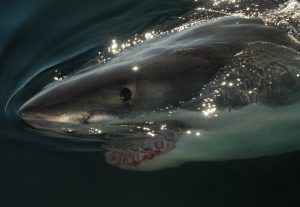
Scientists had known for years that great whites existed in the North Atlantic, but it was a rarity to see one so close to shore, and little was known about great white behavior in the North Atlantic. Little did Skomal know in 2004 that white shark sightings would become commonplace just 10 years later, and he’d deploy many even more sophisticated satellite tracking tags that would reap huge insight into great white behavior in the North Atlantic. The obvious conclusion would link the resurgence of great white sharks in the area with the population boom of seals, but it may not be that simple.
“I wouldn’t attribute the restoration of sharks to the restoration of seals,” states Skomal. “For most of the 20th century, sharks were unexploited biomass. Some people blame Jaws for why that changed, but truth be told, it was more that shark meat became a commodity. No commercial fisherman leaves the dock unless they can make money. It started in the 1980s,” he continues, “Most shark species on the Eastern Seaboard became targeted. White sharks aren’t the most marketable species, but they were being taken too. The effect the movie Jaws had on white sharks is that it made them a favorite target of sport fishermen looking to hook the ultimate fish, like Quint, Brody, and Hooper. They’d charter boats to catch and kill sharks. As a result, the white shark population took a big hit in the ’70s and ’80s.” Then in 1997, the U.S. government prohibited the targeting of great whites. “Now we’re seeing some rebound in their population. Combine their protected status with the overall reduction of the number of hooks in the water and you have a rebound in the populations of several shark species,” says Skomal.
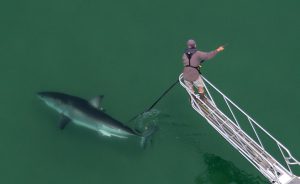 With both the seal and white shark populations on the rise, what will the future bring? Will it turn all of Cape Cod into a real-life Amity Island? Already fishermen are worried about their future, but this rebound of marine life has had an effect on other industries as well. Prior to 2012, the only previously recorded great white shark bite on a human occurred in 1936, and it was a fatal bite. One great white bite was recorded in 2012, and then this past summer (2018), there were two victims of shark bites, both perpetrated by great whites off of Cape Cod beaches — one of which resulted in a fatality. Could this become an alarming trend and how might it affect both the tourism and dive industries on Cape Cod?
With both the seal and white shark populations on the rise, what will the future bring? Will it turn all of Cape Cod into a real-life Amity Island? Already fishermen are worried about their future, but this rebound of marine life has had an effect on other industries as well. Prior to 2012, the only previously recorded great white shark bite on a human occurred in 1936, and it was a fatal bite. One great white bite was recorded in 2012, and then this past summer (2018), there were two victims of shark bites, both perpetrated by great whites off of Cape Cod beaches — one of which resulted in a fatality. Could this become an alarming trend and how might it affect both the tourism and dive industries on Cape Cod?
Where Do We Go From Here?
When asked what the risk is for divers, surfers or simple beachgoers off Cape Cod, Skomal answers, “Trying to quantify the risk for any user group is difficult because there are so few attacks. We (as a society) have really good stats on how likely it is that your 17-year-old will get into a car accident, but trying to calculate the risk of something that occurs so infrequently, like a shark attack, is nearly impossible,” he says. “Largely it’s not a problem … it’s a perception problem — not just for divers, but for all people who go in the ocean. Realistically the risk of being killed in your car is magnitudes higher than being attacked by a shark. But the thought of an animal attacking and killing you is particularly horrifying.”
Skomal is aware of one dive shop that closed its doors as a result of the perceived risk. “People have to view these things more realistically. There are commercial divers, including those that collect lobsters and clams, working off of Cape Cod every day, and so far none of them has been bothered by a white shark. For the most part, when the sharks come in close to shore they’re in full-blown hunting mode, but they’re looking for seals. They don’t particularly like being in water that shallow. Combine that with the limited visibility, which shortens their reaction time, and it’s possible that a mistake could happen. That’s why we recommend using common sense and avoid being in the water in areas where there exists a high density of seals, especially at beaches where the bottom drops off quickly. A mile off the beach where divers might be enjoying one of Cape Cod’s many wrecks, the sharks’ behavior is going to be totally different. There are plenty of areas around Cape Cod where it is still perfectly safe to dive. If I were a dive shop owner, I wouldn’t change my career. I’d just dive more carefully. Offshore wrecks, deeper water and the bayside of Cape Cod should all be fine.”
“We see surfers out on the water almost every day — even in areas where sharks are actively hunting,” says Skomal. Skomal and the state’s environmental police don’t have the authority to legally remove them from the area, but they warn them of the dangers. The surfers largely seem unfazed and go about their business fully aware of the risk. To date, none of them has been attacked. As it turned out, it was not a surfer that was attacked this summer, but rather a boogie boarder in shallow water.
“There are certain conditions which must precipitate an attack, and we’re still studying what exactly they are,” says Skomal. With both populations still on the increase and more and more white shark sightings each year, it calls for some action, but maybe not the drastic action some are hoping for. “In the near term,” says Skomal, “we’ll need to modify our behavior. My job is to identify where the hot spots are and to help advise the public. We’re not going to be able to modify the behavior of either the sharks or the seals. We’ll want to continue our activities in and around the ocean, but some of these activities are more conducive than others to peaceful coexistence. An activity like wading in shallow water to cool off is fine. But, if you go surfing a 100 meters (109 yards) offshore, you may be putting yourself at risk.”
These days, Skomal is in frequent demand on TV. He’s been interviewed by just about every national news agency there is about white sharks off Cape Cod. He energetically spreads his message without panic, but with awe for the natural world and its magnificent animals. Among his many appearances, he does talks for local audiences who throng to see him and learn more about these awesome creatures now showing up in numbers off the coast. After a recent talk, a man approached him and asked if Skomal remembered who he was. It had been five decades since he’d seen him, but Skomal instantly remembered his old scuba instructor. Little did that instructor know when he trained him that he was helping create the real-life Matt Hooper.
Atlantic White Shark Conservancy
To learn more about white shark research and conservation in the North Atlantic, visit atlanticwhiteshark.org. There you’ll find lots of cool photos and information on the sharks, the research and even how you can get involved! If you’re visiting Cape Cod beaches this summer, you might want to download their Sharktivity App (atlanticwhiteshark.org/sharktivity-map/) where you can see on a map real-time sightings and even report your own should you be lucky enough to see one. You can also follow their very active Facebook for lots of photos and videos of what’s going on.
Aerial Photography of Wayne Davis
One of the main ways Dr. Skomal and his team get so close to the sharks is by spotting them from the air. Their pilot, Wayne Davis, is both pilot and photographer. His incredible images of white sharks, seals, whales, Dr. Skomal and his team, as seen from above, are incredible. Have fun getting lost in his site: oceanaerials.com.


